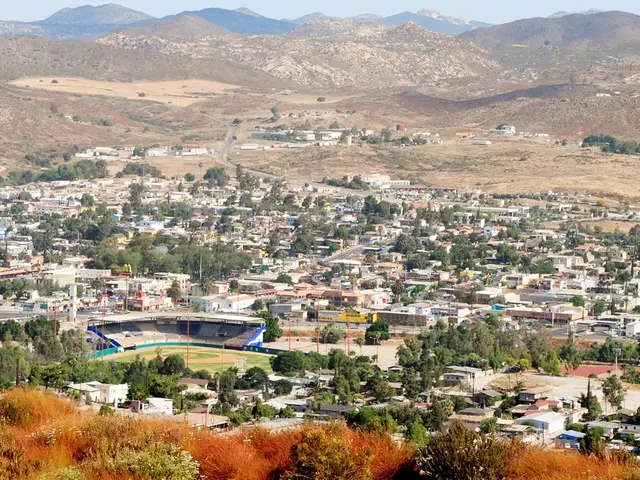Rising inflation in Pakistan reaches 4.1% in July's month-on-month figures
Pakistan is currently undergoing a series of economic reforms under a $7 billion International Monetary Fund (IMF) programme, aimed at fostering structural changes, fiscal discipline, tax system modernization, improving the business climate, and encouraging private sector investment [1][2]. These reforms are part of the Extended Fund Facility (EFF) programme and include transitioning the tax administration from paper-based to digital systems powered by AI, tackling corruption in revenue collection, and implementing climate-related reforms under the Resilience and Sustainability Facility (RSF) [1][2].
Despite ongoing external challenges, these measures have strengthened Pakistan’s macroeconomic stability and rebuilt investor confidence. This is evident in the significant increase in Pakistan’s foreign exchange reserves, which reached $14.51 billion by June 2025—surpassing IMF targets and covering 2.5 months of imports compared to only 1.7 months the previous year [4].
Regarding inflation, the monetary policy committee's statement did not specify the current inflation rate or the potential impacts of the economic reforms on inflation. However, the stabilization of foreign exchange reserves and macroeconomic indicators suggests that inflationary pressures are being addressed through improved fiscal management and monetary policy supported by the IMF programme. The reforms aimed at strengthening fiscal discipline and improving the business environment are typically intended to reduce inflation over the medium term by controlling deficits and supporting growth [2][4].
In July, Pakistan's consumer inflation increased from 3.2% in June to 4.1%. The higher inflation reading was driven by rising prices for food items, fuels, and medicines. In response, the State Bank of Pakistan kept the key interest rate unchanged at 11% [5]. The monetary policy committee suggested that the real policy rate should be adequately positive to keep inflation within the 5%-7% target range [6].
A contractionary government budget was passed in June as part of these economic reforms, with the aim of curbing the fiscal deficit. The increase in inflation was not mentioned in the monetary policy committee's statement, but the State Bank of Pakistan had previously assessed a deteriorating inflation outlook [7].
The monetary policy committee's statement did not provide a timeline for the implementation of the economic reforms, nor did it mention any other factors influencing inflation besides energy prices. However, an unspecified bank's monetary policy committee stated on Wednesday that energy prices, particularly for gas, had risen more than expected [8].
In summary, Pakistan's economic reforms under the IMF programme are aimed at improving fiscal discipline, tax system modernization, business climate, and private sector investment. These measures are designed to reduce inflation over the medium term and boost the economy's stability. Despite the recent increase in inflation, the stabilization of foreign exchange reserves and macroeconomic indicators suggests that inflationary pressures are being addressed through improved fiscal management and monetary policy supported by the IMF programme.
| Reform Area | Description | Impact on Inflation and Economy | |-------------------------------------|------------------------------------------------------|---------------------------------------------------------| | Tax system modernization | Shift to digital and AI-led tax administration | Improves tax equity and revenue, aiding fiscal stability | | Fiscal discipline | Controlling deficits through policy measures | Helps reduce inflationary financing pressures | | Business environment improvements | Encouraging private sector and investment | Supports sustainable growth, indirectly stabilizing prices| | Climate-related reforms | Under the $1.3 billion RSF programme | Enhances economic resilience | | Forex reserves stabilization | Reserves up to $14.51 billion, import cover stable | Supports currency stability, easing imported inflation |
These reforms have collectively helped stabilize the economy and contain inflationary pressures, though the economy still faces challenges in reaching higher growth and sustaining price stability [1][2][3][4].
[1] https://www.imf.org/en/News/Articles/2022/07/20/pr22250-pakistan-2022-articles-iv-executive-board-concludes-2022-article-iv-consultation-discusses-2023-arrangement [2] https://www.dawn.com/news/1672539 [3] https://www.imf.org/en/Publications/WEO/Issues/2022/09/22/world-economic-outlook-update-october-2022 [4] https://www.dawn.com/news/1671868 [5] https://www.dawn.com/news/1672544 [6] https://www.dawn.com/news/1672544 [7] https://www.dawn.com/news/1672544 [8] https://www.dawn.com/news/1672544
The economic reforms in Pakistan, backed by a $7 billion IMF program, focus on fostering fiscal discipline, modernizing the tax system, enhancing the business environment, and implementing climate-related reforms. These measures aim to reduce inflation over the medium term and boost the economy's stability. In spite of the recent increase in consumer inflation, the stabilization of foreign exchange reserves and macroeconomic indicators indicates that inflationary pressures are being addressed through improved fiscal management and monetary policy supported by the IMF program.
The reforms aimed at strengthening fiscal discipline, improving the business environment, and transitioning the tax administration to digital and AI-led systems are typical strategies designed to reduce inflation over the medium term by controlling deficits and supporting growth. Furthermore, the implementation of climate-related reforms under the Resilience and Sustainability Facility (RSF) aims to enhance economic resilience, which could have beneficial long-term effects on inflation and the overall economy.




